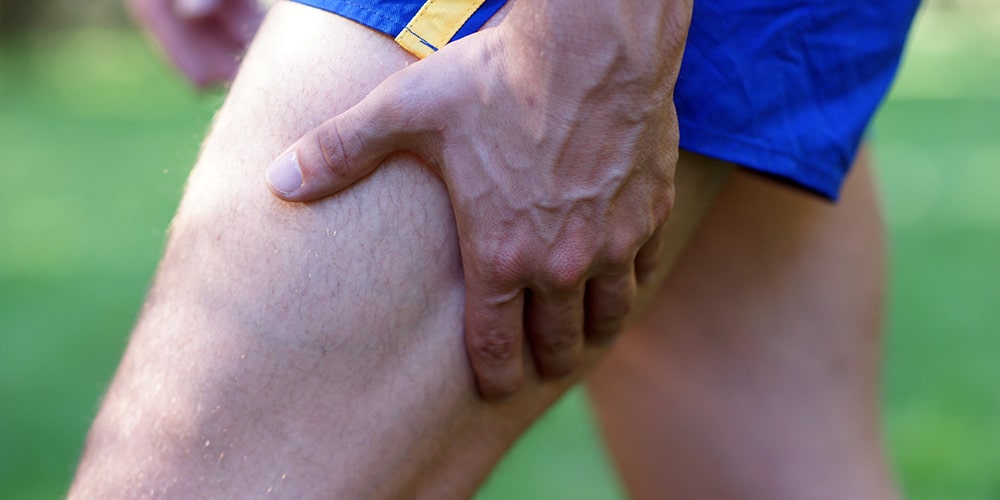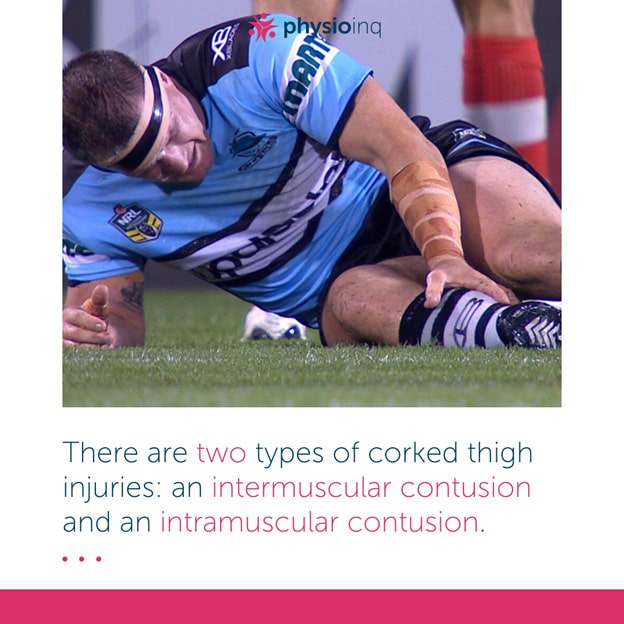
How Long Does It Take for a Corked Thigh to Heal?
Friday, June 25, 2021
If you've played a lot of contact sports like Rugby League, Rugby Union, Soccer or AFL, you might have experienced what's known as a corked thigh injury.
Being struck in the thigh by someone else's knee during a soccer game or by a hard object moving at a high-speed like in a game of tennis, it can cause muscular bruising and bleeding -- not to mention, a whole lot of pain.
So, if you've been hit in the thigh and can't seem to walk or stand, don't worry -- you'll very likely recover. Here, we're going over what a corked thigh actually is, how it's treated, and how long it'll take for a full recovery.
What is a corked thigh?
A corked thigh is a common injury in contact sports caused by a direct hit to the thigh muscle. Also known as a dead leg or a charley horse, a corked thigh is technically a hematoma or contusion.
A hematoma occurs when your muscle gets bruised causing internal bleeding. It can be incredibly painful as your thigh starts to swell and inflame with symptoms such as:
- Inability to walk, run, or climb stairs
- Sitting and lying down can become uncomfortable
- Inability to bend the knee or hinge at the hips
- Swelling and tightness in the thigh muscle
- Bruising
- Mild to severe pain

Risk Factors Associated with a Corked Thigh
The most common cause of a corked thigh is a direct hit to the quadriceps (thigh) muscle. However, there are other risk factors that might cause a corked thigh including:
- Playing contact sports such as Rugby Union, Rugby League, AFL, and Soccer
- Engaging in other sports that require quick starts or changes in direction like running track
- Poor warm-up and cool-down habits
- Poor off-season, pre-season, and mid-season cross-training habits
- Poor muscle conditioning
- A playing position that puts one at risk for more direct contact or tackles
- Level of competitiveness
- Use of protective equipment
- Years of playing experience
- Injury history
- Medical history such as a bleeding condition
- Age
- Poor nutrition
- Poor sleep habits
- Smoking history
- Obesity
These risk factors are all important to take into consideration to help protect yourself from a corked thigh injury.
Types of Corked Thigh
There are two types of corked thigh injuries: an intermuscular contusion and an intramuscular contusion.
An intermuscular contusion refers to bruising between the muscles. An intramuscular contusion refers to bruising within the muscle.
Intermuscular contusions will often present itself with bruising and mild pain but often has a faster recovery time.
Intramuscular contusions, on the other hand, cause much more severe pain, bruising may not be visible, and you'll lose a lot of power and strength in the thigh requiring several weeks for a full recovery.
There are also three grades of corked thighs.
A grade one corked thigh can usually be resolved on its own. In some cases, for example with a rugby player, you might still be able to get back in the game after a grade one corked thigh after a bit of compression and a quick break. The pain of a grade one corked thigh is mild and you might not experience any bruising.
A grade two or three corked thighs have more bruising of the muscle and the bruising may actually continue into the bone causing more complications. You'll experience severe pain and find it extremely debilitating with the inability to bend the knee, walk, sit, or climb stairs.

Image reference – Fox Sports Australia
How Long Does It Take to Recover from a Corked Thigh?
Going back to the different types of corked thighs you might have, knowing which one you're experiencing can give you a better idea of how long the recovery will take.
First, you'll want to figure out whether you have an intermuscular or intramuscular contusion. If you see bruising, you likely have an intermuscular contusion which means your recovery time is likely to be less.
However, if you're still experiencing swelling after two to three days, you probably have an intramuscular contusion, which will have a longer recovery time.
Here are the common recovery times for each grade of a corked thigh:
- Grade 1 Corked Thigh: Up to three weeks
- Grade 2 Corked Thigh: Up to six weeks
- Grade 3 Corked Thigh: Three to twelve weeks
If you're worried that your corked thigh might be worse than you initially expected, be sure to make an appointment with a physiotherapist who can properly assess the injury and work with you on a personalised recovery plan.
How to treat a corked thigh?
The best treatment for a corked thigh happens in two phases: the protection phase and the restoration phase.
Protection Phase
In the protection phase of your corked thigh treatment, you'll want to treat your corked thigh similarly to how you'd treat a typical muscle strain. That means your main goal will be to reduce pain and control the inflammation.
- Keep your thigh compressed and elevated.
- Use ice to the area every one to two hours for about 15 to 20 minutes at a time.
- You might consider taking some anti-inflammatory or pain-relief medication.
- Avoid alcohol as it can increase blood flow to the area and cause issues.
Do not stretch or massage your corked thigh as doing so can make things worse. It's super important that you protect the thigh at this stage to speed up your recovery time.
Restoration Phase
In the restoration phase, you'll work with your physiotherapist to restore your range of motion in the joints surrounding your thigh -- the hip joint above and the knee joint below.
You'll also take time to work on strengthening the muscles of your lower limb including working on the quad, hamstrings, glutes, and calves through exercises like running, jumping, speed and agility challenges, balance exercises, and drills for changing direction.
Working with a Physiotherapist can also help you get back into your sport safely by learning how to take a hit properly and steps you can take to avoid another corked thigh in the future.
How do you tell if you have a corked thigh?
You can tell you have a corked thigh if you experience pain, stiffness and bruising of the thigh muscle after a forceful collision or impact to the area. You probably won't be able to stand, walk, bend your leg or use the thigh muscle in any normal capacity.
Some corked thigh injuries will show all of these symptoms but in some cases, you might only experience one or two of the symptoms.
What can you do for a corked leg?
The best thing to do for a corked leg is to rest, especially in the immediate aftermath of the injury.
So, if you're playing a sport and a collision or fall causes a corked thigh, you'll want to stop play immediately and rest. Sometimes, you'll be able to recover from a corked leg quickly and return to play that day. But, in more intense cases, rest and physiotherapy will be required to make a full recovery.
Can you strap a corked thigh?
Yes, you can strap a corked thigh and use the compression for relief and injury prevention. Since the main types of corked thigh treatment are aiming to reduce pain and inflammation, strapping a corked thigh can help.
The best way to strap a corked thigh is by seeing a physiotherapist and having them either strap your thigh every time or teach you how to strap or tape it yourself. By applying compression both during and after the corked thigh recovery process, you'll be off to a speedier recovery with less chance of reinjury if the compression is worn during activity.
How serious is a thigh contusion?
In general, a thigh contusion is a serious injury, but some contusions are more serious than others.
An intramuscular contusion is more serious than an intermuscular contusion and shows different symptoms requiring different recovery processes. Intermuscular thigh contusions aren't as serious and will generally heal quickly.
Intramuscular thigh contusions are serious injuries and are categorised into various grading. Grade 1 intramuscular thigh contusions will be less serious than Grade 3 intramuscular thigh contusions and will take less time to heal.
Overall, a thigh contusion is not life-threatening but can be incredibly painful and require physiotherapy and rehabilitation.
What is the fastest way to heal a thigh contusion?
The fastest way to heal a thigh contusion is to go through the RICE Method (rest, ice, compression, elevation) and avoid stretching your thigh.
Work with a physiotherapist during your rehabilitation process for the best results when recovering from a thigh contusion. With their expertise, a physio will ensure you are safely rehabilitating your thigh and helping you prevent further contusions with proper strengthening and stretching exercises.
Furthermore, working with a physio to treat your thigh contusion decreases the likelihood of your contusion worsening into something called myositis ossificans which can further complicate your injury.
What does a thigh contusion feel like?
A thigh contusion can feel like a cramp, Charlie horse or dead leg with, in many cases, extreme pain. You won't be able to walk or even stand on your leg with a thigh contusion.
Dealing with a corked thigh injury? Reach out to one of our expert physiotherapists who can help you through the recovery process. We can even come to you using our amazing mobile physio services OR clinic services. Our Physio Inq team will get you back in the game in no time!
This article was originally written by Jonathan Moody from Physio Inq

